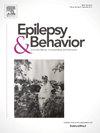癫痫状态是癫痫患者意外猝死(SUDEP)的风险因素:范围综述和叙述性综述。
IF 2.3
3区 医学
Q2 BEHAVIORAL SCIENCES
引用次数: 0
摘要
背景:癫痫患者意外猝死(SUDEP)是导致癫痫患者死亡的主要原因。癫痫发作频率增加、耐药性癫痫和癫痫发病过早等风险因素已得到广泛认可。然而,几乎没有证据表明癫痫发作的严重程度,特别是癫痫状态(SE)对 SUDEP 风险的作用:目的:确定 SE 与 SUDEP 之间重叠的机制、风险因素和临床特征:方法:由两名审稿人使用合适的检索词,采用 PRISMA-ScR 模型进行范围界定审查。利用 PubMed 高级搜索工具和祖先法来识别 1992 年 6 月至 2023 年 5 月间发表的合适文章。其中包括定量、定性和混合方法研究。进行了叙述性综合,并以主题和次主题的形式呈现:在初步搜索确定的 5453 篇论文中,有 50 项研究适合进行最终分析。关键主题包括 SE 并发症与 SUDEP 危险因素(药物耐受性全身强直阵挛性癫痫、智力障碍)之间的重叠、共同危险因素(酗酒、发育性癫痫性脑病)和临床特征(心脏和呼吸系统)之间的重叠。SE在耐药性癫痫发展中的作用是SE导致SUDEP风险的最强有力的潜在机制。SE 对反复发作性低氧血症和心率变异性降低的作用表明,SE 与 SUDEP 的关系需要进一步研究:本综述确定了 SE 对 SUDEP 风险影响的研究领域。此类研究可为关注癫痫发作严重程度的患者提供与其 SUDEP 风险相关的咨询服务,并优化对 SE 后致痫结果的监测和后续管理。本文章由计算机程序翻译,如有差异,请以英文原文为准。
Status Epilepticus a risk factor for Sudden Unexpected Death in Epilepsy (SUDEP): A scoping review and narrative synthesis
Background
Sudden Unexpected Death in Epilepsy (SUDEP) is a leading cause of mortality among people with epilepsy (PWE). Risk factors such as increased seizure frequency, drug-resistant epilepsy, and early epilepsy onset are well recognised. However, little evidence of the role of seizure severity, specifically Status Epilepticus (SE) on SUDEP risk exists.
Objective
To identify mechanisms, risk factors and clinical characteristics overlap between SE and SUDEP.
Methods
A scoping review using the PRISMA-ScR model was performed by two reviewers using suitable search terms. The PubMed Advanced Search tool along with the ancestry method was utilised to identify suitable articles published between 06/1992 and 05/2023. Quantitative, qualitative and mixed method studies were included. A narrative synthesis was undertaken and is presented as themes and subthemes.
Results
Of 5453 papers identified in the preliminary search, 50 studies were suitable for final analysis. Key themes include overlap between SE complications and SUDEP risk factors (pharmaco-resistant generalised tonic-clonic epilepsy, intellectual disability), overlap of shared risk factors (alcohol abuse, developmental epileptic encephalopathies) and clinical characteristics (cardiac and respiratory). SE’s role in development of drug-resistant epilepsy was the strongest potential mechanism for SE’s contribution to SUDEP risk. SE’s contribution to recurrent ictal hypoxaemia episodes and lowered heart rate variability suggests a relationship with SUDEP needing further study.
Conclusions
This review identifies research areas of influence of SE on SUDEP risk. Such research could inform counselling for patients concerned about seizure severity in relation to their SUDEP risk and optimise surveillance and subsequent management of post-SE epileptogenic outcomes.
求助全文
通过发布文献求助,成功后即可免费获取论文全文。
去求助
来源期刊

Epilepsy & Behavior
医学-行为科学
CiteScore
5.40
自引率
15.40%
发文量
385
审稿时长
43 days
期刊介绍:
Epilepsy & Behavior is the fastest-growing international journal uniquely devoted to the rapid dissemination of the most current information available on the behavioral aspects of seizures and epilepsy.
Epilepsy & Behavior presents original peer-reviewed articles based on laboratory and clinical research. Topics are drawn from a variety of fields, including clinical neurology, neurosurgery, neuropsychiatry, neuropsychology, neurophysiology, neuropharmacology, and neuroimaging.
From September 2012 Epilepsy & Behavior stopped accepting Case Reports for publication in the journal. From this date authors who submit to Epilepsy & Behavior will be offered a transfer or asked to resubmit their Case Reports to its new sister journal, Epilepsy & Behavior Case Reports.
 求助内容:
求助内容: 应助结果提醒方式:
应助结果提醒方式:


